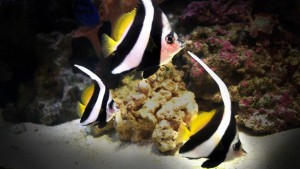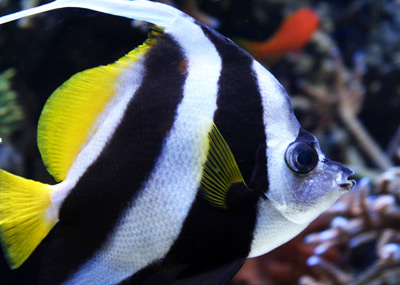Mother Nature must have a special place in her heart for marine aquarium hobbyists. It seems as though for every heartbreakingly challenging reef fish she created, she did us a solid by making a reasonable facsimile that is much hardier and better suited to aquarium life. Such is the case with the schooling bannerfish (Heniochus diphreutes) from the Indo-Pacific, which bears a striking resemblance to the coveted—but notoriously hard to keep—Moorish idol (Zanclus cornutus).
Though H. diphreutes is commonly dubbed the “poor man’s Moorish idol” or the “false Moorish idol,” these monikers do this species a great disservice in my opinion because they imply that it’s somehow a lesser species. After all, what’s “lesser” about a fish that’s almost certain to survive in your aquarium? (Maybe the Moorish idol should be called the “poor man’s schooling bannerfish”!)
Okay, maybe one could reasonably argue that it’s not quite as exotic-looking as Z. cornutus, particularly in the face (as a member of the family Chaetodontidae, H. diphreutes has a “typical” butterflyfish face), but the overall visual impression H. diphreutes creates in the aquarium—with its laterally compressed body; black, white, and yellow coloration; and long, trailing dorsal extension—is almost identical. Besides, H. diphreutes readily accepts standard aquarium fare and requires little coaxing to initiate feeding. Contrast that with Z. cornutas, which very commonly refuses food to the point of starvation in captivity.
Yes, you can keep a school
Fish that can actually be kept more than one to a tank are a rare commodity in the marine aquarium hobby, but H. diphreutes, as its common name suggests, is a noteworthy exception. If kept in a large enough tank (at least 125 gallons, with bigger being better) that offers plenty of open swimming space, multiple specimens can be kept together provided all are introduced simultaneously. I wouldn’t go any smaller than 100 gallons for a single specimen—this is an energetic species that can reach upwards of 8 inches.
Feeding is easy
As I mentioned, H. diphreutes presents little challenge when it comes to feeding. A planktivore by nature, it will snatch any small meaty foods drifting in the water column and will even accept dry pellets and flakes. Some greens, such as a commercial formulation for herbivores, should be included on the menu as well.
Peaceful tankmates, please!
Based on personal experience with this species, I can attest that it can be the target of harassment by more-aggressive species. I once introduced a specimen that was bullied relentlessly by a flame angelfish and pearlscale butterflyfish. The flame angel even went so far as to nip a chunk out of the bannerfish’s banner. I would limit tankmates to other relatively peaceful species, and as far as order of introduction is concerned, I’d add the banner(s) early on. I suspect my bullied bannerfish would have fared better in the same tank had it been introduced ahead of its tormentors.
Reef safety
I’ve never kept H. diphreutes in a reef tank, but it’s known to be inoffensive toward sessile invertebrates. However, do be aware that other Heniochus spp. are sometimes available in the hobby, some of which are more or less reef-safe than others.
For example, the almost-identical-looking longfin bannerfish (H. acuminatus) is reputed to be a threat to sessile invertebrates. To tell these two species apart, look closely at the anal fin. On H. diphreutes, the posterior vertical black band extends all the way to the point of the anal fin, while on H. acuminatus, the black band terminates above the point of the fin. Supposedly there are also differences in the snout length and the fullness of the two species’ chests, but unless you have both species side by side for comparison, these aren’t necessarily the best distinguishing characteristics to look for. If you plan to buy banners for a reef tank and have any doubt about their identity, be sure to verify the species with your dealer.




